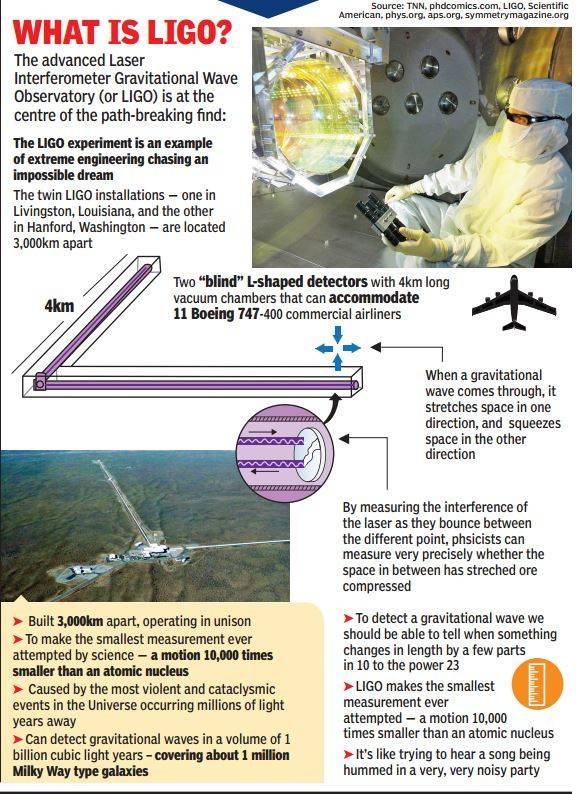Gravitational waves research and India


This is a collection of articles archived for the excellence of their content. |
India’s role
The Times of India, Feb 12, 2016
Swati Shinde
Gravitational waves discovery: India’s imprint in landmark LIGO project
Indian groups contributed significantly to the historic search for gravitational waves. The key tasks they carried out included the following:
- Understanding the response of the LIGO detector to the signals and terrestrial influences
- Bounding the orbital eccentricity and estimating the mass and spin of the final black hole
- Estimating energy and power radiated during merger
- Confirming that observed signal agrees with Einstein's Theory of Relativity
- Searching for a possible electromagnetic counterpart using optical telescopes.
Some of these jobs were carried out in high performance computing facilities at IUCAA, Pune and ICTS, Bengaluru. The group, led by Bala Iyer at the Raman Research Institute in collaboration with scientists in France, had pioneered the mathematical calculations used to model gravitational wave signals from orbiting black holes and neutron stars. Another group led by Sanjeev Dhurandhar at IUCAA initiated and carried out foundation work on developing data analysis techniques to detect these weak gravitational wave signals buried in the detector noise by looking for the best match between the calculated waveforms and the detector signal.
Meanwhile, the director of Pune's Inter-University Centre for Astronomy and Astrophysics (IUCAA) Somak Raychaudhury said he was looking forward to the launch of a similar observatory in India.
A similar facility is being planned in India in a direction opposite to the two American observatories in Louisiana and Washington. "We need detectors in many more directions so that the exact route of the gravitational wave can be traced... hence, the proposal to set up an observatory in India," Raychaudhury told. LIGO-India is being envisaged as a collaborative project between a consortium of Indian research institutions, the LIGO Lab in the US and its other international partners. The Centre has offered a funding of Rs 1,200 crore for the project. While the LIGO lab is set to provide the complete design and the key detector components, Indian scientists will be responsible for the infrastructure to install the detector at a suitable site in India.
LIGO-India
India Today.in , Edge of the earth “India Today” 15/12/2016
2016
LIGO-INDIA
Edge of the Earth
To foster cutting-edge research, the Laser Interferometer Gravitational Wave Observatory in India (LIGO-India) project is setting up a state-of-the-art gravitational wave observatory in collaboration with the LIGO Laboratory in the US, run by Caltech and MIT. The Department of Atomic Energy has identified Aundha, in Hingoli district of Maharasthra, as the preferred site. Topographical, seismological and geotechnical assessments are vital, as the location must be one of low seismic disturbance. The science is fascinating: almost 100 years after Albert Einstein first predicted them, researchers detected gravitational waves-ripples in the fabric of space-time that had radiated out from the merging of two black holes. While this confirms Einstein's general theory of relativity, it also provided evidence that the theory breaks down at the 'event horizon' of black holes. The first research operations will begin only in 2024, for which the DAE and Department of Science and Technology have reached an agreement with the US's National Science Foundation.